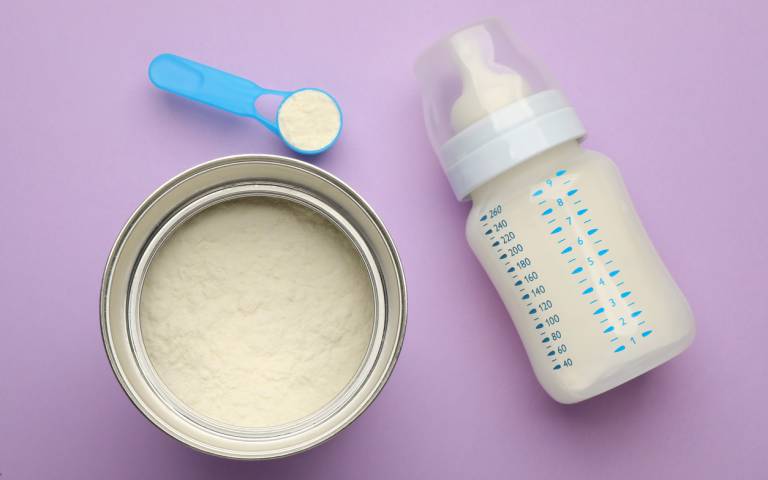Baby formula manufacturers are marketing their products in ways that contravene guidance from the Department of Health and Social Care (DHSC), according to a new study by UCL researchers.

The peer-reviewed study, published in the journal Public Health Nutrition, analysed the wording and images on 71 formula products available in UK supermarkets and pharmacies.
Text and images on baby formula are regulated to ensure they do not discourage breastfeeding. The legislation is set out in broad terms, and more detailed DHSC guidance is intended to help companies comply with this regulation.
In the study, researchers found that two-thirds (67%) of infant formula packs (for babies from birth) showed images that the DHSC guidance advises against, because they may idealise the use of formula. These include images of baby animals, toys, cots and graphics representing nursing mothers.
Meanwhile, a large minority of packs displayed health claims (18%) and nutritional claims (41%) not permitted under the guidance.
Examples of non-permitted images and text found on infant formula packs:
- Images of teddy bears, baby elephants, baby polar bears, a stork carrying a bundle in its beak;
- Health claims such as "contains all the nutrients your baby needs to grow strong and healthy". (Only wording taken from a specific approved list of health claims is allowed.)
- Nutritional information such as "2'FL" and "LNnT" - these are not permitted as they are highly technical and are unlikely to be understood by consumers.
The researchers also found messages that were not clear health claims but could be understood in a similar way, for instance that a company had been leading research in baby nutrition for 100 years and that their formula had been "expertly created with nature in mind".
Companies are not required to follow the DHSC guidance, and the research team called for underlying legislation to be updated to prevent companies from inappropriately promoting formula milk.
Lead author Dr Rana Conway (UCL Behavioural Science & Health) said: "Current legislation is too vague and leaves companies to interpret the rules as they wish. The lack of detail means it was difficult for us to establish clear breaches in the packaging we analysed. However, we found many examples of companies marketing their products in ways that the DHSC guidance considers inappropriate, as well as using sophisticated marketing techniques to get around the rules.
"Previous research shows parents generally trust marketing claims and that these beliefs shape infant feeding decisions, increase formula use and can undermine advice or decisions to breastfeed. Our results add to concerns that marketing techniques are being used to mislead caregivers about the similarity of formula to breast milk and the superiority of expensive products over cheaper ones."
Senior author Dr Clare Llewellyn (UCL Behavioural Science & Health) said: "The legislation needs to be far more specific to prevent companies from bypassing guidance to promote infant formula. Parents must be supported in making infant feeding decisions based on their own and their family's needs, without commercial influence."
Exclusive breastfeeding is recommended for the first six months of a baby's life. Although the health benefits of breastfeeding are well established, the UK has one of the lowest rates of breastfeeding in the world (1% of babies are exclusively breastfed for the first six months, compared to 19% in the US and 18% in the Netherlands).
Health and nutritional claims about formula milk are not permitted, to ensure that products are not seen as equivalent or superior to breast milk. The ingredient and nutrient content of formula is also strictly controlled, and as a result there are no significant nutrient differences between brands.
The researchers also found that infant formula and follow-on formula (marketed for use from six months of age) packs were highly similar, despite legislation stating these should be clearly distinguishable to avoid misuse. The two products are supposed to look different because firms can advertise and promote follow-on formula, but this must not cross-promote infant formula through similar branding.
They found that, based on DHSC guidance, 72% of infant and follow-on formula packs were categorised as showing a high degree of similarity. The legislation currently does not define "similarity", so there are no criteria to determine if breaches have occurred.
In addition, the study found that marketing practices not covered by current legislation were widespread. For example, 94% of infant formula packs included advertisements for follow-on formula or growing-up formula.
As well as facilitating cross-promotion, this helps convey the message that infants should progress from one product to the next, which is not consistent with healthy eating guidelines to breastfeed or use either infant formula up to one year of age or cow's milk from one year of age.
The findings support the World Health Organisation's call for loopholes in Breast Milk Substitute legislation to be closed as a matter of urgency. The study was conducted for the Obesity Policy Research Unit.
DHSC guidance is intended to "facilitate adherence to and assessment of adherence to the legislation", but the DHSC says it "should not be taken as an authoritative statement on how the law should be interpreted".






